 American Journal of Plant Sciences, 2011, 2, 496-506 doi:10.4236/ajps.2011.23058 Published Online September 2011 (http://www.SciRP.org/journal/ajps) Copyright © 2011 SciRes. AJPS The Taxonomic History and Original Literatures Arrangements of Living Cephalotaxus (Cephalotaxaceae) Xuedong Lang1,2, Jianrong Su1*, Zhijun Zhang1, Shugang Lu2 1Research Institute of Resources Insects, Chinese Academy of Forestry, Kunming, China; 2College of Life Sciences, Yunnan Univer- sity, Kunming, China. Email: *jianrongsu@vip.sina.com Received June 8th, 2011; revised July 19th, 2011; accepted July 28th, 2011. ABSTRACT Living Cephalotaxus (plum yews) occurs mainly in East Asia and North of Indo-China peninsula. The study of original taxonomic literatures found that, in early days, the plum yews had ever been described as palnts of Taxus (Taxaceae). Since after the genus name Cephalotaxus Sieb. & Zucc. was firstly cited (from inedited and unpublished Flora Japonica) by Endlicher in 1842, most taxonomist thought which is the earliest time of the genus Cephalotaxus Sieb. & Zucc. was set. However, the genus Cephalotaxus Sieb. & Zucc. was formally effective and valid published by Sieb. & Zucc. in Flora Japonica in 1870 so that there exists some confusions in chronological order. Originally as a genus, Cephalo- taxus was included in family Taxaceae and Neger (1907) separated Cephalotaxus from Taxaceae and set family Cephalotaxaceae. Later, Fu (1984) divided Cephalotaxus up into two sections of Cephalotaxus Sieb. & Zucc. sect. Pectinatae L. K. Fu and Cephalotaxus Sieb. & Zucc. sect. Cephalotaxus L. K. Fu on the bases of C. oliveri Masters differ significantly from other taxa of Cephalotaxus in morphological characteristics. Although the plum yews was a little genus of conifers, up to now, about 77 taxa have still been published by taxonomist in different countries or re- gions. Among them, C. tardiva Sieb. ex Endl. (1847), C. umbraculifera Sieb. ex Endl. (1847), C. sumatrana Miq. (1856) and C. celebica Warb. (1900) have been combined to Taxus, and C. argotaenia (Hance) Pilger (1903) has been com- bined to Amentotaxus. And at the same time, those taxa existing in Cephalotaxus courently which were accepted by most taxonomist in different countries were also cited in acticle. Lastly, the paper found presently there still exists many debates about binary classification of Cephalotaxus and the nomenclature of this genus still particularly confusing. Based on some controversial problems, we also point out some taxonomically researching directions at creating some order out of the chaos. Keywords: Cephalotaxus, Taxonomic History, Literatures Arrangements, Controversial Problems, Researching Directions 1. Introduction Living plants of Cephalotaxus (plum yews) was a little taxon of conifers which occurs mainly in East Asia and North of Indo-China peninsula—Japan (Ohwi [1]), Korea (Nakai [2]), Chinese Mainland (Fu [3]) and Taiwan (Li and Keng [4]), Northeast India (Hook. f. [5]), Burma (Fu [3]), Laos (Newman [6]; Thomas et al. [7]), Tailand (Phengklai [8]; Werner [9]), Malysia (Forbes [10]), and parts of Vietnam (Hiep et al. [11]) (Figure 1). The mod- ern natural range of Cephalotaxus has diminished con- siderably from that of its early antecedents was found in Europe and northwestern North America in the Mio- ceneand Pliocene eras, and even during the Jurassicera its antecedents also extended into what is now Greenland (Tripp [12]). In early days, the plum yews were described as palnts of Taxus (Taxaceae) which can be known from Forbes [10] named a plant, growing on the Penang Range of mountains in Malaysia and was introduced to England in 1837 by Mr. Knight, as Taxus harringtonii Knight ex Forbes (“harringtonia”) (now it is a basionmy of Cephalo- taxus harringtonii (Knight ex Forbes) Koch [13]). And since two names (two nomen nudum) of C. drupacea Sieb. et Zucc. and C. pedunculata Sieb. et Zucc. were first at the same time used by Siebold and Zuccarini [14] in Florae Japonicae Familiae Naturales (page 108) or Abhandlungen der Akademie der Wissenschaften in München (page 232), 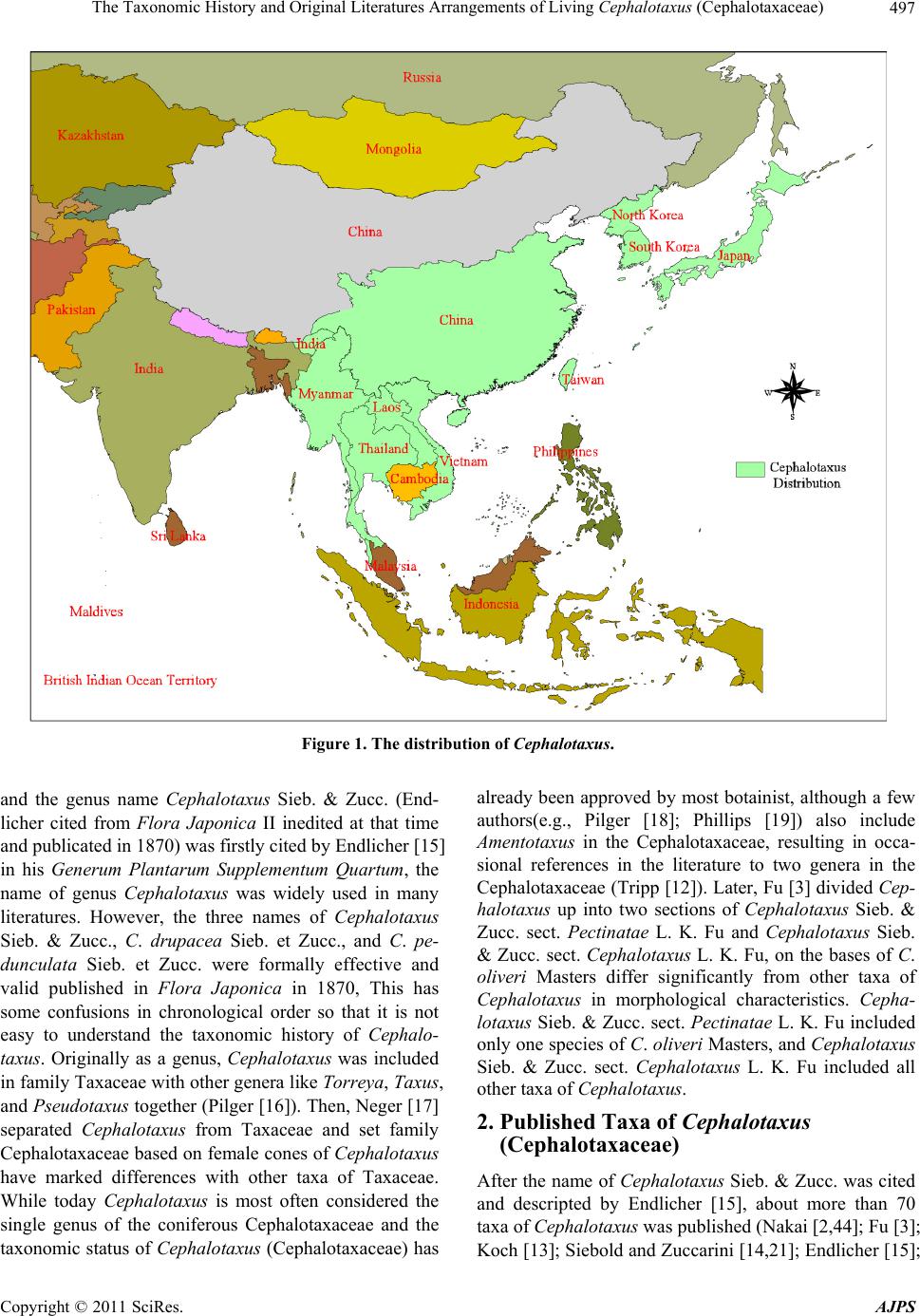 The Taxonomic History and Original Literatures Arrangements of Living Cephalotaxus (Cephalotaxaceae) 497 Figure 1. The distribution of Cephalotaxus. and the genus name Cephalotaxus Sieb. & Zucc. (End- licher cited from Flora Japonica II inedited at that time and publicated in 1870) was firstly cited by Endlicher [15] in his Generum Plantarum Supplementum Quartum, the name of genus Cephalotaxus was widely used in many literatures. However, the three names of Cephalotaxus Sieb. & Zucc., C. drupacea Sieb. et Zucc., and C. pe- dunculata Sieb. et Zucc. were formally effective and valid published in Flora Japonica in 1870, This has some confusions in chronological order so that it is not easy to understand the taxonomic history of Cephalo- taxus. Originally as a genus, Cephalotaxus was included in family Taxaceae with other genera like Torreya, Taxu s, and Pseudotaxus together (Pilger [16]). Then, Neger [17] separated Cephalotaxus from Taxaceae and set family Cephalotaxaceae based on female cones of Cephalotaxus have marked differences with other taxa of Taxaceae. While today Cephalotaxus is most often considered the single genus of the coniferous Cephalotaxaceae and the taxonomic status of Cephalotaxus (Cephalotaxaceae) has already been approved by most botainist, although a few authors(e.g., Pilger [18]; Phillips [19]) also include Amentotaxus in the Cephalotaxaceae, resulting in occa- sional references in the literature to two genera in the Cephalotaxaceae (Tripp [12]). Later, Fu [3] divided Cep- halotaxus up into two sections of Cephalotaxus Sieb. & Zucc. sect. Pectinatae L. K. Fu and Cephalotaxus Sieb. & Zucc. sect. Cephalotaxus L. K. Fu, on the bases of C. oliveri Masters differ significantly from other taxa of Cephalotaxus in morphological characteristics. Cepha- lotaxus Sieb. & Zucc. sect. Pectinatae L. K. Fu included only one species of C. oliveri Masters, and Cephalotaxus Sieb. & Zucc. sect. Cephalotaxus L. K. Fu included all other taxa of Cephalotaxus. 2. Published Taxa of Cephalotaxus (Cephalotaxaceae) After the name of Cephalotaxus Sieb. & Zucc. was cited and descripted by Endlicher [15], about more than 70 taxa of Cephalotaxu s was published (Nakai [2,44]; Fu [3]; Koch [13]; Siebold and Zuccarini [14,21]; Endlicher [15]; Copyright © 2011 SciRes. AJPS 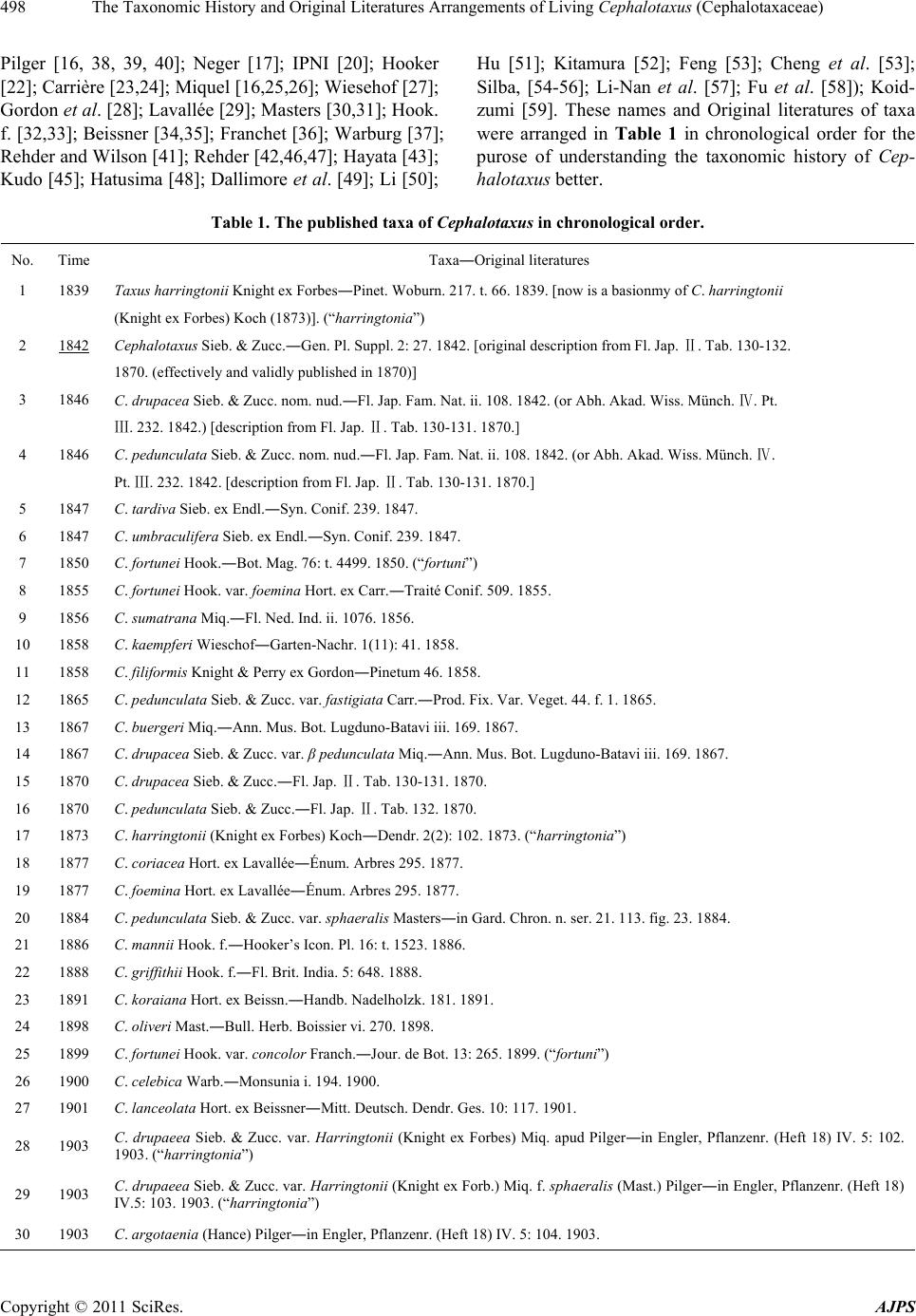 The Taxonomic History and Original Literatures Arrangements of Living Cephalotaxus (Cephalotaxaceae) 498 Pilger [16, 38, 39, 40]; Neger [17]; IPNI [20]; Hooker [22]; Carrière [23,24]; Miquel [16,25,26]; Wiesehof [27]; Gordon et al. [28]; Lavallée [29]; Masters [30,31]; Hook. f. [32,33]; Beissner [34,35]; Franchet [36]; Warburg [37]; Rehder and Wilson [41]; Rehder [42,46,47]; Hayata [43]; Kudo [45]; Hatusima [48]; Dallimore et al. [49]; Li [50]; Hu [51]; Kitamura [52]; Feng [53]; Cheng et al. [53]; Silba, [54-56]; Li-Nan et al. [57]; Fu et al. [58]); Koid- zumi [59]. These names and Original literatures of taxa were arranged in Table 1 in chronological order for the purose of understanding the taxonomic history of Cep- halotaxus better. Table 1. The published taxa of Cephalotaxus in chronological order. No. Time Taxa―Original literatures 1 1839 Taxus harringtonii Knight ex Forbes―Pinet. Woburn. 217. t. 66. 1839. [now is a basionmy of C. harringtonii (Knight ex Forbes) Koch (1873)]. (“harringtonia”) 2 1842 Cephalotaxus Sieb. & Zucc.―Gen. Pl. Suppl. 2: 27. 1842. [original description from Fl. Jap. Ⅱ. Tab. 130-132. 1870. (effectively and validly published in 1870)] 3 1846 C. drupacea Sieb. & Zucc. nom. nud.―Fl. Jap. Fam. Nat. ii. 108. 1842. (or Abh. Akad. Wiss. Münch. Ⅳ. Pt. Ⅲ. 232. 1842.) [description from Fl. Jap. Ⅱ. Tab. 130-131. 1870.] 4 1846 C. pedunculata Sieb. & Zucc. nom. nud.―Fl. Jap. Fam. Nat. ii. 108. 1842. (or Abh. Akad. Wiss. Münch. Ⅳ. Pt. Ⅲ. 232. 1842. [description from Fl. Jap. Ⅱ. Tab. 130-131. 1870.] 5 1847 C. tardiva Sieb. ex Endl.―Syn. Conif. 239. 1847. 6 1847 C. umbraculifera Sieb. ex Endl.―Syn. Conif. 239. 1847. 7 1850 C. fortunei Hook.―Bot. Mag. 76: t. 4499. 1850. (“fortuni”) 8 1855 C. fortunei Hook. var. foemina Hort. ex Carr.―Traité Conif. 509. 1855. 9 1856 C. sumatrana Miq.―Fl. Ned. Ind. ii. 1076. 1856. 10 1858 C. kaempferi Wieschof―Garten-Nachr. 1(11): 41. 1858. 11 1858 C. filiformis Knight & Perry ex Gordon―Pinetum 46. 1858. 12 1865 C. pedunculata Sieb. & Zucc. var. fastigiata Carr.―Prod. Fix. Var. Veget. 44. f. 1. 1865. 13 1867 C. buergeri Miq.―Ann. Mus. Bot. Lugduno-Batavi iii. 169. 1867. 14 1867 C. drupacea Sieb. & Zucc. var. β pedunculata Miq.―Ann. Mus. Bot. Lugduno-Batavi iii. 169. 1867. 15 1870 C. drupacea Sieb. & Zucc.―Fl. Jap. Ⅱ. Tab. 130-131. 1870. 16 1870 C. pedunculata Sieb. & Zucc.―Fl. Jap. Ⅱ. Tab. 132. 1870. 17 1873 C. harringtonii (Knight ex Forbes) Koch―Dendr. 2(2): 102. 1873. (“harringtonia”) 18 1877 C. coriacea Hort. ex Lavallée―Énum. Arbres 295. 1877. 19 1877 C. foemina Hort. ex Lavallée―Énum. Arbres 295. 1877. 20 1884 C. pedunculata Sieb. & Zucc. var. sphaeralis Masters―in Gard. Chron. n. ser. 21. 113. fig. 23. 1884. 21 1886 C. mannii Hook. f.―Hooker’s Icon. Pl. 16: t. 1523. 1886. 22 1888 C. griffithii Hook. f.―Fl. Brit. India. 5: 648. 1888. 23 1891 C. koraiana Hort. ex Beissn.―Handb. Nadelholzk. 181. 1891. 24 1898 C. oliveri Mast.―Bull. Herb. Boissier vi. 270. 1898. 25 1899 C. fortunei Hook. var. concolor Franch.―Jour. de Bot. 13: 265. 1899. (“fortuni”) 26 1900 C. celebica Warb.―Monsunia i. 194. 1900. 27 1901 C. lanceolata Hort. ex Beissner―Mitt. Deutsch. Dendr. Ges. 10: 117. 1901. 28 1903 C. drupaeea Sieb. & Zucc. var. Harringtonii (Knight ex Forbes) Miq. apud Pilger―in Engler, Pflanzenr. (Heft 18) IV. 5: 102. 1903. (“harringtonia”) 29 1903 C. drupaeea Sieb. & Zucc. var. Harringtonii (Knight ex Forb.) Miq. f. sphaeralis (Mast.) Pilger―in Engler, Pflanzenr. (Heft 18) IV.5: 103. 1903. (“harringtonia”) 30 1903 C. argotaenia (Hance) Pilger―in Engler, Pflanzenr. (Heft 18) IV. 5: 104. 1903. Copyright © 2011 SciRes. AJPS 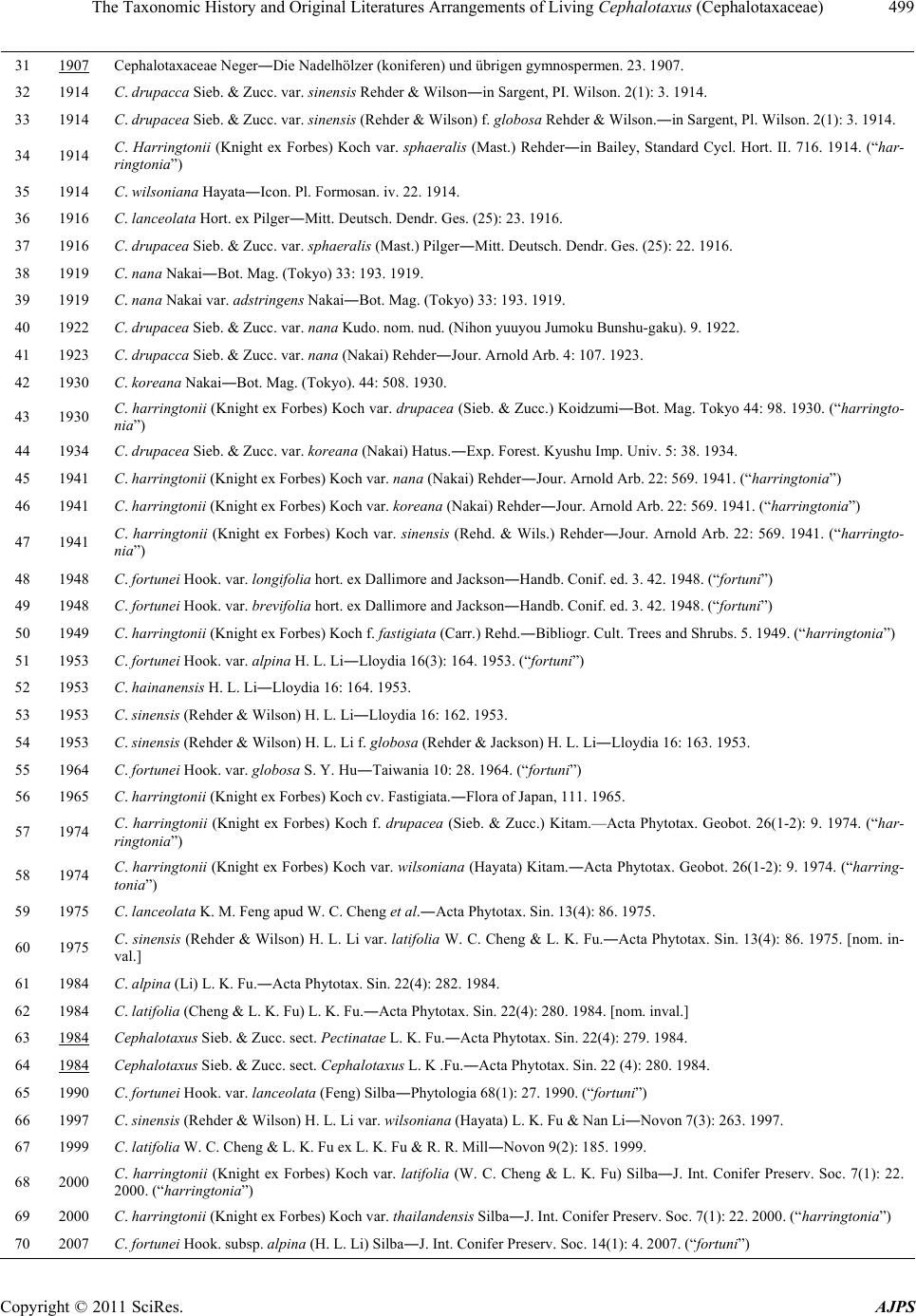 The Taxonomic History and Original Literatures Arrangements of Living Cephalotaxus (Cephalotaxaceae)499 31 1907 Cephalotaxaceae Neger―Die Nadelhölzer (koniferen) und übrigen gymnospermen. 23. 1907. 32 1914 C. drupacca Sieb. & Zucc. var. sinensis Rehder & Wilson―in Sargent, PI. Wilson. 2(1): 3. 1914. 33 1914 C. drupacea Sieb. & Zucc. var. sinensis (Rehder & Wilson) f. globosa Rehder & Wilson.―in Sargent, Pl. Wilson. 2(1): 3. 1914. 34 1914 C. Harringtonii (Knight ex Forbes) Koch var. sphaeralis (Mast.) Rehder―in Bailey, Standard Cycl. Hort. II. 716. 1914. (“har- ringtonia”) 35 1914 C. wilsoniana Hayata―Icon. Pl. Formosan. iv. 22. 1914. 36 1916 C. lanceolata Hort. ex Pilger―Mitt. Deutsch. Dendr. Ges. (25): 23. 1916. 37 1916 C. drupacea Sieb. & Zucc. var. sphaeralis (Mast.) Pilger―Mitt. Deutsch. Dendr. Ges. (25): 22. 1916. 38 1919 C. nana Nakai―Bot. Mag. (Tokyo) 33: 193. 1919. 39 1919 C. nana Nakai var. adstringens Nakai―Bot. Mag. (Tokyo) 33: 193. 1919. 40 1922 C. drupacea Sieb. & Zucc. var. nana Kudo. nom. nud. (Nihon yuuyou Jumoku Bunshu-gaku). 9. 1922. 41 1923 C. drupacca Sieb. & Zucc. var. nana (Nakai) Rehder―Jour. Arnold Arb. 4: 107. 1923. 42 1930 C. koreana Nakai―Bot. Mag. (Tokyo). 44: 508. 1930. 43 1930 C. harringtonii (Knight ex Forbes) Koch var. drupacea (Sieb. & Zucc.) Koidzumi―Bot. Mag. Tokyo 44: 98. 1930. (“harringto- nia”) 44 1934 C. drupacea Sieb. & Zucc. var. koreana (Nakai) Hatus.―Exp. Forest. Kyushu Imp. Univ. 5: 38. 1934. 45 1941 C. harringtonii (Knight ex Forbes) Koch var. nana (Nakai) Rehder―Jour. Arnold Arb. 22: 569. 1941. (“harringtonia”) 46 1941 C. harringtonii (Knight ex Forbes) Koch var. koreana (Nakai) Rehder―Jour. Arnold Arb. 22: 569. 1941. (“harringtonia”) 47 1941 C. harringtonii (Knight ex Forbes) Koch var. sinensis (Rehd. & Wils.) Rehder―Jour. Arnold Arb. 22: 569. 1941. (“harringto- nia”) 48 1948 C. fortunei Hook. var. longifolia hort. ex Dallimore and Jackson―Handb. Conif. ed. 3. 42. 1948. (“fortuni”) 49 1948 C. fortunei Hook. var. brevifolia hort. ex Dallimore and Jackson―Handb. Conif. ed. 3. 42. 1948. (“fortuni”) 50 1949 C. harringtonii (Knight ex Forbes) Koch f. fastigiata (Carr.) Rehd.―Bibliogr. Cult. Trees and Shrubs. 5. 1949. (“harringtonia”) 51 1953 C. fortunei Hook. var. alpina H. L. Li―Lloydia 16(3): 164. 1953. (“fortuni”) 52 1953 C. hainanensis H. L. Li―Lloydia 16: 164. 1953. 53 1953 C. sinensis (Rehder & Wilson) H. L. Li―Lloydia 16: 162. 1953. 54 1953 C. sinensis (Rehder & Wilson) H. L. Li f. globosa (Rehder & Jackson) H. L. Li―Lloydia 16: 163. 1953. 55 1964 C. fortunei Hook. var. globosa S. Y. Hu―Taiwania 10: 28. 1964. (“fortuni”) 56 1965 C. harringtonii (Knight ex Forbes) Koch cv. Fastigiata.―Flora of Japan, 111. 1965. 57 1974 C. harringtonii (Knight ex Forbes) Koch f. drupacea (Sieb. & Zucc.) Kitam.—Acta Phytotax. Geobot. 26(1-2): 9. 1974. (“har- ringtonia”) 58 1974 C. harringtonii (Knight ex Forbes) Koch var. wilsoniana (Hayata) Kitam.―Acta Phytotax. Geobot. 26(1-2): 9. 1974. (“harring- tonia”) 59 1975 C. lanceolata K. M. Feng apud W. C. Cheng et al.―Acta Phytotax. Sin. 13(4): 86. 1975. 60 1975 C. sinensis (Rehder & Wilson) H. L. Li var. latifolia W. C. Cheng & L. K. Fu.―Acta Phytotax. Sin. 13(4): 86. 1975. [nom. in- val.] 61 1984 C. alpina (Li) L. K. Fu.―Acta Phytotax. Sin. 22(4): 282. 1984. 62 1984 C. latifolia (Cheng & L. K. Fu) L. K. Fu.―Acta Phytotax. Sin. 22(4): 280. 1984. [nom. inval.] 63 1984 Cephalotaxus Sieb. & Zucc. sect. Pectinatae L. K. Fu.―Acta Phytotax. Sin. 22(4): 279. 1984. 64 1984 Cephalotaxus Sieb. & Zucc. sect. Cephalotaxus L. K .Fu.―Acta Phytotax. Sin. 22 (4): 280. 1984. 65 1990 C. fortunei Hook. var. lanceolata (Feng) Silba―Phytologia 68(1): 27. 1990. (“fortuni”) 66 1997 C. sinensis (Rehder & Wilson) H. L. Li var. wilsoniana (Hayata) L. K. Fu & Nan Li―Novon 7(3): 263. 1997. 67 1999 C. latifolia W. C. Cheng & L. K. Fu ex L. K. Fu & R. R. Mill―Novon 9(2): 185. 1999. 68 2000 C. harringtonii (Knight ex Forbes) Koch var. latifolia (W. C. Cheng & L. K. Fu) Silba―J. Int. Conifer Preserv. Soc. 7(1): 22. 2000. (“harringtonia”) 69 2000 C. harringtonii (Knight ex Forbes) Koch var. thailandensis Silba―J. Int. Conifer Preserv. Soc. 7(1): 22. 2000. (“harringtonia”) 70 2007 C. fortunei Hook. subsp. alpina (H. L. Li) Silba―J. Int. Conifer Preserv. Soc. 14(1): 4. 2007. (“fortuni”) Copyright © 2011 SciRes. AJPS 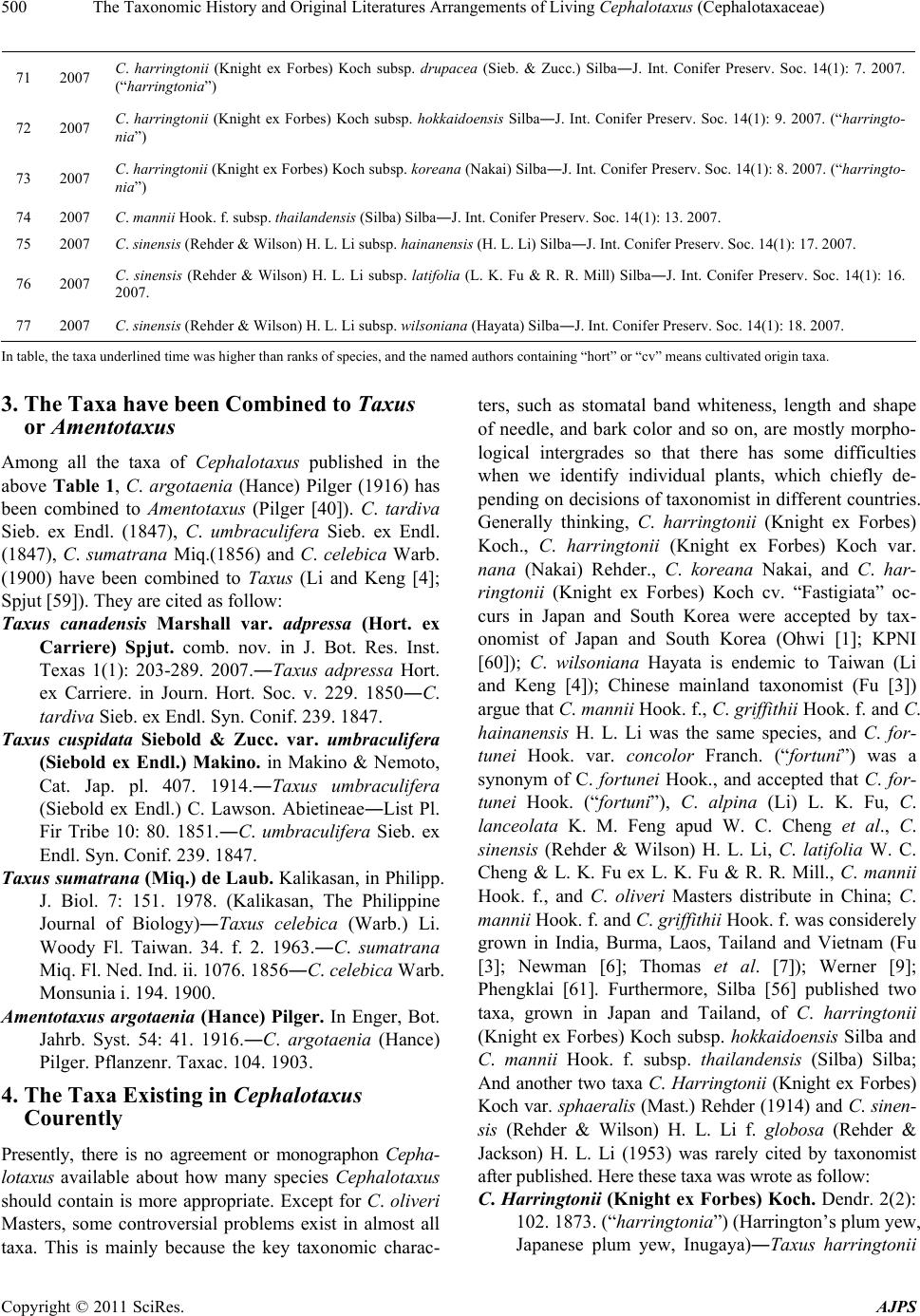 The Taxonomic History and Original Literatures Arrangements of Living Cephalotaxus (Cephalotaxaceae) Copyright © 2011 SciRes. AJPS 500 71 2007 C. harringtonii (Knight ex Forbes) Koch subsp. drupacea (Sieb. & Zucc.) Silba―J. Int. Conifer Preserv. Soc. 14(1): 7. 2007. (“harringtonia”) 72 2007 C. harringtonii (Knight ex Forbes) Koch subsp. hokkaidoensis Silba―J. Int. Conifer Preserv. Soc. 14(1): 9. 2007. (“harringto- nia”) 73 2007 C. harringtonii (Knight ex Forbes) Koch subsp. koreana (Nakai) Silba―J. Int. Conifer Preserv. Soc. 14(1): 8. 2007. (“harringto- nia”) 74 2007 C. mannii Hook. f. subsp. thailandensis (Silba) Silba―J. Int. Conifer Preserv. Soc. 14(1): 13. 2007. 75 2007 C. sinensis (Rehder & Wilson) H. L. Li subsp. hainanensis (H. L. Li) Silba―J. Int. Conifer Preserv. Soc. 14(1): 17. 2007. 76 2007 C. sinensis (Rehder & Wilson) H. L. Li subsp. latifolia (L. K. Fu & R. R. Mill) Silba―J. Int. Conifer Preserv. Soc. 14(1): 16. 2007. 77 2007 C. sinensis (Rehder & Wilson) H. L. Li subsp. wilsoniana (Hayata) Silba―J. Int. Conifer Preserv. Soc. 14(1): 18. 2007. In table, the taxa underlined time was higher than ranks of species, and the named authors containing “hort” or “cv” means cultivated origin taxa. 3. The Taxa have been Combined to Taxus or Amentotaxus Among all the taxa of Cephalotaxus published in the above Table 1, C. argotaenia (Hance) Pilger (1916) has been combined to Amentotaxus (Pilger [40]). C. tardiva Sieb. ex Endl. (1847), C. umbraculifera Sieb. ex Endl. (1847), C. sumatrana Miq.(1856) and C. celebica Warb. (1900) have been combined to Taxus (Li and Keng [4]; Spjut [59]). They are cited as follow: Taxus canadensis Marshall var. adpressa (Hort. ex Carriere) Spjut. comb. nov. in J. Bot. Res. Inst. Texas 1(1): 203-289. 2007.―Taxus adpressa Hort. ex Carriere. in Journ. Hort. Soc. v. 229. 1850―C. tardiva Sieb. ex Endl. Syn. Conif. 239. 1847. Taxus cuspidata Siebold & Zucc. var. umbraculifera (Siebold ex Endl.) Makino. in Makino & Nemoto, Cat. Jap. pl. 407. 1914.―Taxus umbraculifera (Siebold ex Endl.) C. Lawson. Abietineae―List Pl. Fir Tribe 10: 80. 1851.―C. umbraculifera Sieb. ex Endl. Syn. Conif. 239. 1847. Taxus sumatrana (Miq.) de Laub. Kalikasan, in Philipp. J. Biol. 7: 151. 1978. (Kalikasan, The Philippine Journal of Biology)―Taxus celebica (Warb.) Li. Woody Fl. Taiwan. 34. f. 2. 1963.―C. sumatrana Miq. Fl. Ned. Ind. ii. 1076. 1856―C. celebica Warb. Monsunia i. 194. 1900. Amentotaxus argotaenia (Hance) Pilger. In Enger, Bot. Jahrb. Syst. 54: 41. 1916.―C. argotaenia (Hance) Pilger. Pflanzenr. Taxac. 104. 1903. 4. The Taxa Existing in Cephalotaxus Courently Presently, there is no agreement or monographon Cepha- lotaxus available about how many species Cephalotaxus should contain is more appropriate. Except for C. oliveri Masters, some controversial problems exist in almost all taxa. This is mainly because the key taxonomic charac- ters, such as stomatal band whiteness, length and shape of needle, and bark color and so on, are mostly morpho- logical intergrades so that there has some difficulties when we identify individual plants, which chiefly de- pending on decisions of taxonomist in different countries. Generally thinking, C. harringtonii (Knight ex Forbes) Koch., C. harringtonii (Knight ex Forbes) Koch var. nana (Nakai) Rehder., C. koreana Nakai, and C. har- ringtonii (Knight ex Forbes) Koch cv. “Fastigiata” oc- curs in Japan and South Korea were accepted by tax- onomist of Japan and South Korea (Ohwi [1]; KPNI [60]); C. wilsoniana Hayata is endemic to Taiwan (Li and Keng [4]); Chinese mainland taxonomist (Fu [3]) argue that C. mannii Hook. f., C. griffithii Hook. f. and C. hainanensis H. L. Li was the same species, and C. for- tunei Hook. var. concolor Franch. (“fortuni”) was a synonym of C. fortunei Hook., and accepted that C. for- tunei Hook. (“fortuni”), C. alpina (Li) L. K. Fu, C. lanceolata K. M. Feng apud W. C. Cheng et al., C. sinensis (Rehder & Wilson) H. L. Li, C. latifolia W. C. Cheng & L. K. Fu ex L. K. Fu & R. R. Mill., C. mannii Hook. f., and C. oliveri Masters distribute in China; C. mannii Hook. f. and C. griffithii Hook. f. was considerely grown in India, Burma, Laos, Tailand and Vietnam (Fu [3]; Newman [6]; Thomas et al. [7]); Werner [9]; Phengklai [61]. Furthermore, Silba [56] published two taxa, grown in Japan and Tailand, of C. harringtonii (Knight ex Forbes) Koch subsp. hokkaidoensis Silba and C. mannii Hook. f. subsp. thailandensis (Silba) Silba; And another two taxa C. Harringtonii (Knight ex Forbes) Koch var. sphaeralis (Mast.) Rehder (1914) and C. sinen- sis (Rehder & Wilson) H. L. Li f. globosa (Rehder & Jackson) H. L. Li (1953) was rarely cited by taxonomist after published. Here these taxa was wrote as follow: C. Harringtonii (Knight ex Forbes) Koch. Dendr. 2(2): 102. 1873. (“harringtonia”) (Harrington’s plum yew, Japanese plum yew, Inugaya)―Taxus harringtonii  The Taxonomic History and Original Literatures Arrangements of Living Cephalotaxus (Cephalotaxaceae)501 Knight ex Forbes. Pinet. Woburn. 217. t. 66. 1839.―C. drupacea Sieb. & Zucc. Fl. Jap. Fam. Nat. ii. 108. 1842. (or Abh. Akad. Wiss. Münch. IV. Pt. III. 232. 1842.) nom. nod., descr. Sieb. & Zucc. Fl. Jap. II. Tab. 130-131. 1870.―C. pedunculata Sieb. & Zucc. Fl. Jap. Fam. Nat. ii. 108. 1842. (or Abh. Akad. Wiss. Münch. IV. Pt. III. 232. 1842.) nom. nod., descr. Sieb. & Zucc. Fl. Jap. II. Tab. 132. 1870.―C. fortunei Hook. var. foemina Hort. ex Carr. Traité. Conif. 509. 1855. (“fortuni”)―C. dru- pacea Sieb. & Zucc. var. β pedunculata Miq. Ann. Mus. Bot. Lugduno-Batavi iii. 169. 1867.―C. cori- acea Hort. ex Lavallée. Énum. Arbres. 295. 1877.―C. foemina Hort. ex Lavallée. Énum. Arbres. 295. 1877.―C. drupaeea Sieb. & Zucc. var. Har- ringtonii (Knight ex Forbes) Miq. in Engler, Pflan- zenr. (Heft 18) IV. 5: 102. 1903.―C. harringtonii (Knight ex Forbes) var. drupacea (Sieb. & Zucc.) Koidzumi. in Bot. Mag. Tokyo 44: 98. 1930.―C. harringtonii (Knight ex Forbes) f. drupacea (Sieb. & Zucc.) Kitam. in Acta Phytotax. Geobot. 26(1-2): 9. 1974.―C. harringtonii (Knight ex Forbes) Koch subsp. drupacea (Sieb. & Zucc.) Silba. in J. Int. Conifer Preserv. Soc. 14(1): 7. 2007. C. Harringtonii (Knight ex Forbes) Koch var. nana (Nakai) Rehder. in Jour. Arnold Arb. 22: 569. 1941. (“harringtonia”) (Dwarf plum yew)―C. nana Na- kai. in Bot. Mag. (Tokyo) 33: 193. 1919.―C. nana Nakai var. adstringens Nakai. in Bot. Mag. (Tokyo) 33: 193. 1919.―C. drupacea Sieb. & Zucc. var. nana Kudo. nom. nud. Nihon yuuyou Jumoku Bun- shu-gaku. 9. 1922.?―C. drupacca Sieb. & Zucc. var. nana (Nakai) Rehder. in Jour. Arnold Arb. 4: 107. 1923. C. Harringtonii (Knight ex Forbes) Koch var. sphaer- alis (Mast.) Rehder. in Bailey, Standard Cycl. Hort. II. 716. 1914. (“harringtonia”)―C. pedunculata Sieb. & Zucc. var. sphaeralis Masters. in Gard. Chron. n. ser. 21. 113. fig. 23. 1884.―C. drupaeea Sieb. & Zucc. var. Harringtonii (Knight ex Forb.) Miq. f. sphaeralis (Mast.) Pilger. in Engler, Pflan- zenr. (Heft 18) IV. 5: 103. 1903.―C. drupacea Sieb. & Zucc. var. sphaeralis (Mast.) Pilger. in Mitt. Deutsch. Dendr. Ges. (25): 22. 1916. C. Harringtonii (Knight ex Forbes) Koch subsp. hok- kaidoensis Silba. in J. Int. Conifer Preserv. Soc. 14(1): 9. 2007. (“harringtonia”) C. Harringtonii (Knight ex Forbes) Koch cv. “Fas- tigiata”. in Flora of Japan(in English). 111. 1965. (“harringtonia”)―C. harringtonii (Knight ex Forbes) Koch f. fastigiata (Carr.) Rehd. in Bibliogr. Cult. Trees and Shrubs 5. 1949.―C. pedunculata Sieb. & Zucc. var. fastigiata Carr. in Prod. Fix. Var. Veget. 44. f. 1. 1865.―C. buergeri Miq. Ann. Mus. Bot. Lugduno-Batavi iii. 169. 1891. [Cited from Flora of Japan (in English) (Ohwi [1])]. C. koreana Nakai. in Bot. Mag. (Tokyo). 44: 508. 1930. (Korean plum yew)―C. drupacea Sieb. & Zucc. var. koreana (Nakai) Hatus. Exp. Forest. Kyushu Imp. Univ. 5: 38. 1934.―C. harringtonii (Knight ex Forbes) Koch var. koreana (Nakai) Rehder. in Jour. Arnold Arb. 22: 569. 1941. (“harringtonia”)―C. harringtonii (Knight ex Forbes) Koch subsp. kore- ana (Nakai) Silba. in J. Int. Conifer Preserv. Soc. 14(1): 18. 2007. (“harringtonia”) C. wilsoniana Hayata. Icon. Pl. Formosan. iv. 22. 1914. (Wilson plum yew, Taiwan plum yew).―C. har- ringtonii (Knight ex Forbes) Koch var. wilsoniana (Hayata) Kitam. in Acta Phytotax. Geobot. 26(1-2): 9. 1974. (“harringtonia”)―C. sinensis (Rehder & Wilson) H. L. Li. var. wilsoniana (Hayata) L. K. Fu & Nan Li. in Novon 7(3): 263. 1997.―C. sinensis (Rehder & Wilson) H. L. Li subsp. wilsoniana (Ha- yata) Silba. in J. Int. Conifer Preserv. Soc. 14(1): 18. 2007. C. fortunei Hook. Bot. Mag. 76: t. 4499. 1850. (“for - tuni”) (Fortune’s plum yew)―C. fortunei Hook. Gordon. Pinetum. 46: 1858. (“fortunii”)―C. kaempferi Wieschof. in Garten-Nachr. 1(11): 41. 1858.―C. filiformis Knight & Perry ex Gordon. Pinetum. 46. 1858.―C. fortunei Hook. var. con- color Franch. in Jour. de Bot. 13: 265. 1899. (“for- tuni”)―C. lanceolata Hort. ex Beissner. in Mitt. Deutsch. Dendr. Ges. 10: 117. 1901.―C. lanceolata Hort. ex Pilger. in Mitt. Deutsch. Dendr. Ges. (25): 23. 1916.―C. fortunei Hook. var. longifolia Hort. ex Dallimore and Jackson. Handb. Conif. ed. 3. 42. 1948.―C. fortunei Hook. var. brevifolia Hort. ex Dallimore and Jackson. Handb. Conif. ed. 3. 42. 1948.―C. fortunei Hook. Li Hui-Lin. in Lloydia. 16 (3): 164. 1953. (“fortuni”)―C. fortunei Hook. Cheng Wan-Jun et al. in Fl. Reip. Pop. Sin. 7: 426-427. 1978; Fu Li-Guo. in Acta Phytotax. Sin. 22 (4): 282-283. 1984; Silba. in J. Int. Conifer Pre- serv. Soc. 14(1): 3. 2007. (“Hook. f.”) C. alpina (Li) L. K. Fu. in Acta Phytotax. Sin. 22(4): 282. 1984.―C. fortunei Hook. var. alpina H. L. Li. in Lloydia 16(3): 164. 1953.―C. fortunei Hook. var. globosa S. Y. Hu. in Taiwania 10: 28. 1964.―C. fortunei Hook. subsp. alpina (H. L. Li) Silba. in J. Int. Conifer Preserv. Soc. 14(1): 4. 2000. C. lanceolata K. M. Feng apud W. C. Cheng et al. in Acta Phytotax. Sin. 13(4): 86. 1975.―C. fortunei Hook. var. lanceolata (Feng) Silba. in Phytologia 68(1): 27. 1990. (“fortuni”) C. sinensis (Rehder & Wilson) H. L. Li. in Lloydia 16: Copyright © 2011 SciRes. AJPS 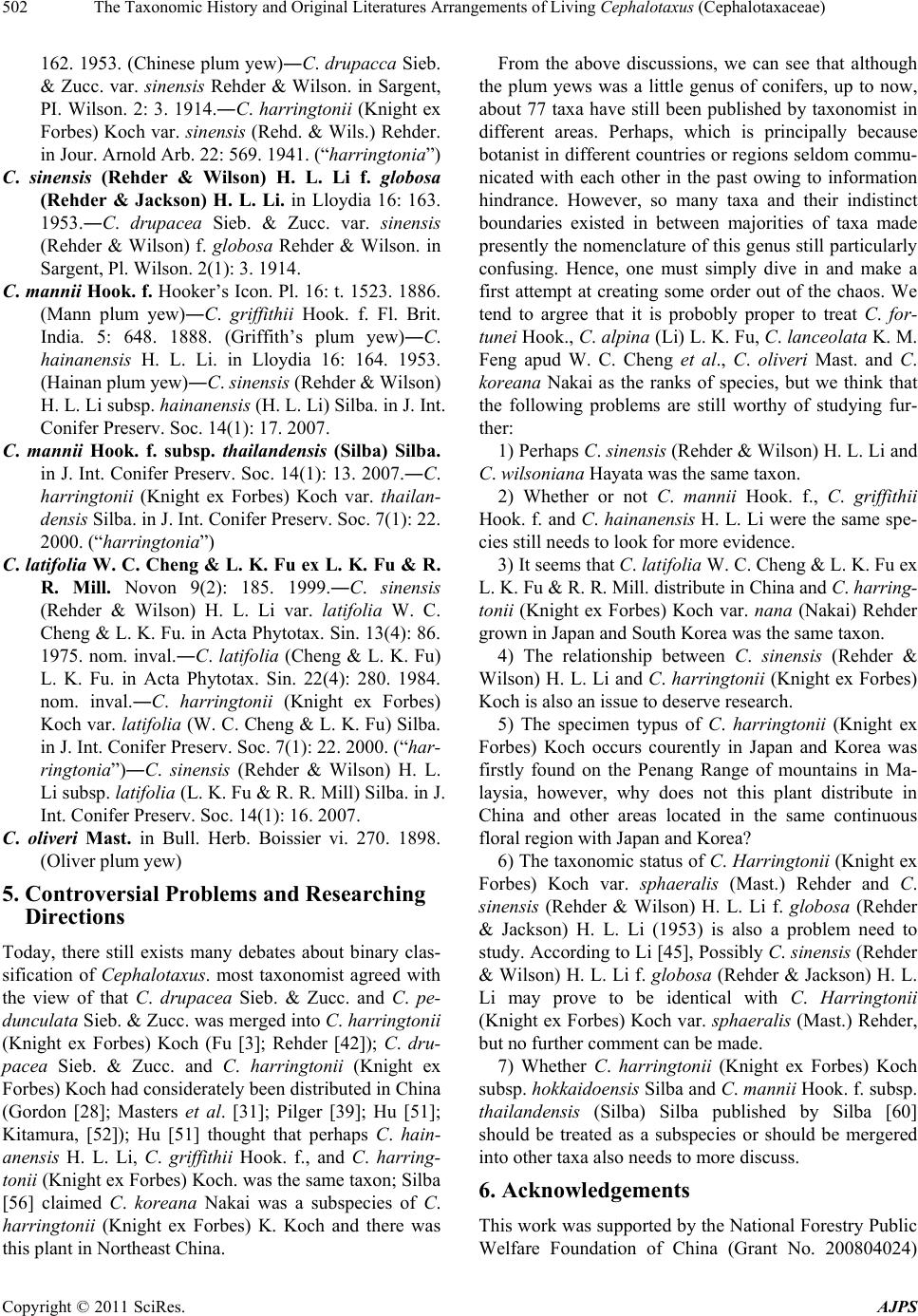 The Taxonomic History and Original Literatures Arrangements of Living Cephalotaxus (Cephalotaxaceae) 502 162. 1953. (Chinese plum yew)―C. drupacca Sieb. & Zucc. var. sinensis Rehder & Wilson. in Sargent, PI. Wilson. 2: 3. 1914.―C. harringtonii (Knight ex Forbes) Koch var. sinensis (Rehd. & Wils.) Rehder. in Jour. Arnold Arb. 22: 569. 1941. (“harringtonia”) C. sinensis (Rehder & Wilson) H. L. Li f. globosa (Rehder & Jackson) H. L. Li. in Lloydia 16: 163. 1953.―C. drupacea Sieb. & Zucc. var. sinensis (Rehder & Wilson) f. globosa Rehder & Wilson. in Sargent, Pl. Wilson. 2(1): 3. 1914. C. mannii Hook. f. Hooker’s Icon. Pl. 16: t. 1523. 1886. (Mann plum yew)―C. griffithii Hook. f. Fl. Brit. India. 5: 648. 1888. (Griffith’s plum yew)―C. hainanensis H. L. Li. in Lloydia 16: 164. 1953. (Hainan plum yew)―C. sinensis (Rehder & Wilson) H. L. Li subsp. hainanensis (H. L. Li) Silba. in J. Int. Conifer Preserv. Soc. 14(1): 17. 2007. C. mannii Hook. f. subsp. thailandensis (Silba) Silba. in J. Int. Conifer Preserv. Soc. 14(1): 13. 2007.―C. harringtonii (Knight ex Forbes) Koch var. thailan- densis Silba. in J. Int. Conifer Preserv. Soc. 7(1): 22. 2000. (“harringtonia”) C. latifolia W. C. Cheng & L. K. Fu ex L. K. Fu & R. R. Mill. Novon 9(2): 185. 1999.―C. sinensis (Rehder & Wilson) H. L. Li var. latifolia W. C. Cheng & L. K. Fu. in Acta Phytotax. Sin. 13(4): 86. 1975. nom. inval.―C. latifolia (Cheng & L. K. Fu) L. K. Fu. in Acta Phytotax. Sin. 22(4): 280. 1984. nom. inval.―C. harringtonii (Knight ex Forbes) Koch var. latifolia (W. C. Cheng & L. K. Fu) Silba. in J. Int. Conifer Preserv. Soc. 7(1): 22. 2000. (“har- ringtonia”)―C. sinensis (Rehder & Wilson) H. L. Li subsp. latifolia (L. K. Fu & R. R. Mill) Silba. in J. Int. Conifer Preserv. Soc. 14(1): 16. 2007. C. oliveri Mast. in Bull. Herb. Boissier vi. 270. 1898. (Oliver plum yew) 5. Controversial Problems and Researching Directions Today, there still exists many debates about binary clas- sification of Cephalotaxus. most taxonomist agreed with the view of that C. drupacea Sieb. & Zucc. and C. pe- dunculata Sieb. & Zucc. was merged into C. harringtonii (Knight ex Forbes) Koch (Fu [3]; Rehder [42]); C. dru- pacea Sieb. & Zucc. and C. harringtonii (Knight ex Forbes) Koch had considerately been distributed in China (Gordon [28]; Masters et al. [31]; Pilger [39]; Hu [51]; Kitamura, [52]); Hu [51] thought that perhaps C. hain- anensis H. L. Li, C. griffithii Hook. f., and C. harring- tonii (Knight ex Forbes) Koch. was the same taxon; Silba [56] claimed C. koreana Nakai was a subspecies of C. harringtonii (Knight ex Forbes) K. Koch and there was this plant in Northeast China. From the above discussions, we can see that although the plum yews was a little genus of conifers, up to now, about 77 taxa have still been published by taxonomist in different areas. Perhaps, which is principally because botanist in different countries or regions seldom commu- nicated with each other in the past owing to information hindrance. However, so many taxa and their indistinct boundaries existed in between majorities of taxa made presently the nomenclature of this genus still particularly confusing. Hence, one must simply dive in and make a first attempt at creating some order out of the chaos. We tend to argree that it is probobly proper to treat C. for- tunei Hook., C. alpina (Li) L. K. Fu, C. lanceolata K. M. Feng apud W. C. Cheng et al., C. oliveri Mast. and C. koreana Nakai as the ranks of species, but we think that the following problems are still worthy of studying fur- ther: 1) Perhaps C. sinensis (Rehder & Wilson) H. L. Li and C. wilsoniana Hayata was the same taxon. 2) Whether or not C. mannii Hook. f., C. griffithii Hook. f. and C. hainanensis H. L. Li were the same spe- cies still needs to look for more evidence. 3) It seems that C. latifolia W. C. Cheng & L. K. Fu ex L. K. Fu & R. R. Mill. distribute in China and C. harring- tonii (Knight ex Forbes) Koch var. nana (Nakai) Rehder grown in Japan and South Korea was the same taxon. 4) The relationship between C. sinensis (Rehder & Wilson) H. L. Li and C. harringtonii (Knight ex Forbes) Koch is also an issue to deserve research. 5) The specimen typus of C. harringtonii (Knight ex Forbes) Koch occurs courently in Japan and Korea was firstly found on the Penang Range of mountains in Ma- laysia, however, why does not this plant distribute in China and other areas located in the same continuous floral region with Japan and Korea? 6) The taxonomic status of C. Harringtonii (Knight ex Forbes) Koch var. sphaeralis (Mast.) Rehder and C. sinensis (Rehder & Wilson) H. L. Li f. globosa (Rehder & Jackson) H. L. Li (1953) is also a problem need to study. According to Li [45], Possibly C. sinensis (Rehder & Wilson) H. L. Li f. globosa (Rehder & Jackson) H. L. Li may prove to be identical with C. Harringtonii (Knight ex Forbes) Koch var. sphaeralis (Mast.) Rehder, but no further comment can be made. 7) Whether C. harringtonii (Knight ex Forbes) Koch subsp. hokkaidoensis Silba and C. mannii Hook. f. subsp. thailandensis (Silba) Silba published by Silba [60] should be treated as a subspecies or should be mergered into other taxa also needs to more discuss. 6. Acknowledgements This work was supported by the National Forestry Public Welfare Foundation of China (Grant No. 200804024) Copyright © 2011 SciRes. AJPS 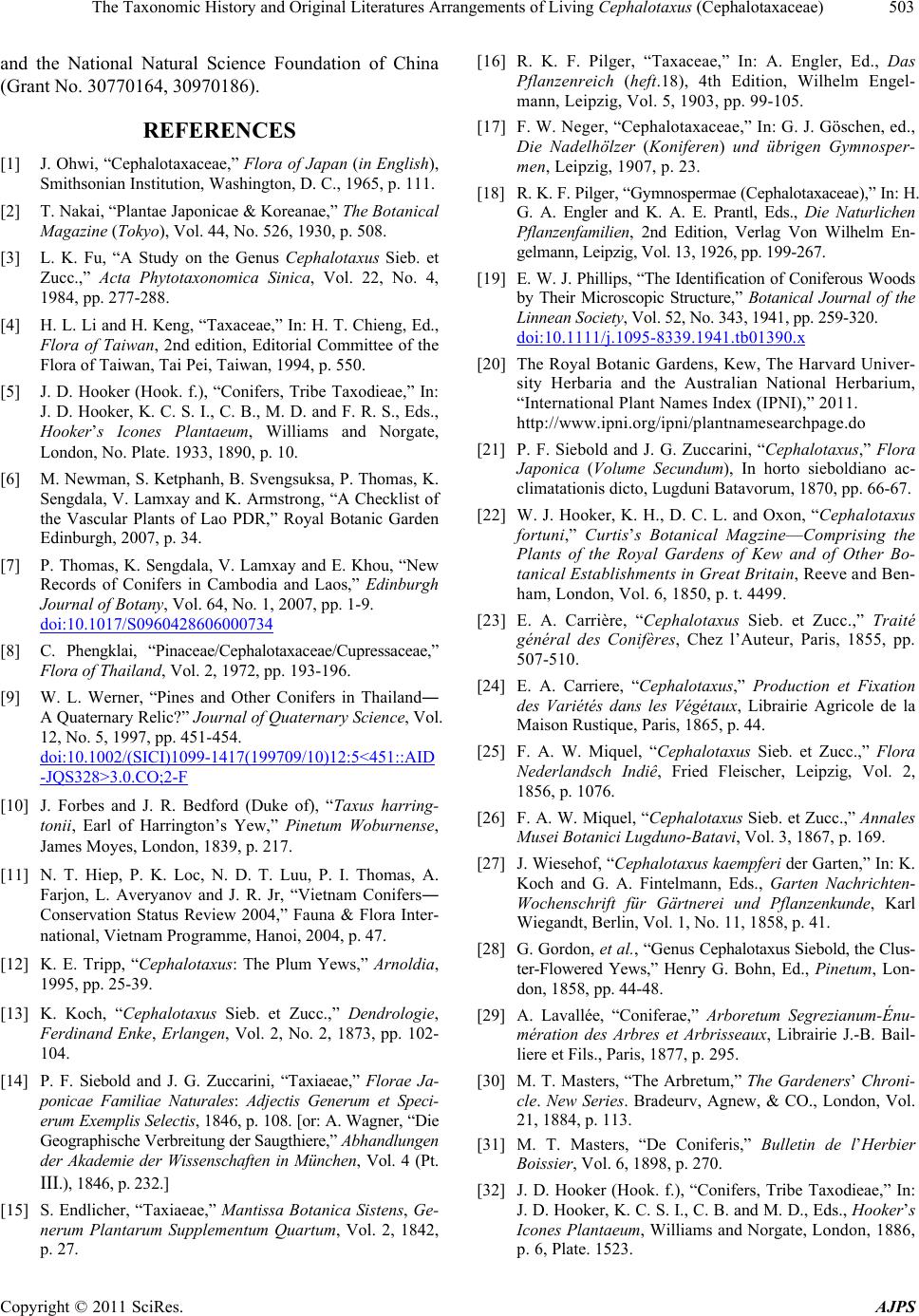 The Taxonomic History and Original Literatures Arrangements of Living Cephalotaxus (Cephalotaxaceae)503 and the National Natural Science Foundation of China (Grant No. 30770164, 30970186). REFERENCES [1] J. Ohwi, “Cephalotaxaceae,” Flora of Japan (in English), Smithsonian Institution, Washington, D. C., 1965, p. 111. [2] T. Nakai, “Plantae Japonicae & Koreanae,” The Botanical Magazine (Tokyo), Vol. 44, No. 526, 1930, p. 508. [3] L. K. Fu, “A Study on the Genus Cephalotaxus Sieb. et Zucc.,” Acta Phytotaxonomica Sinica, Vol. 22, No. 4, 1984, pp. 277-288. [4] H. L. Li and H. Keng, “Taxaceae,” In: H. T. Chieng, Ed., Flora of Taiwan, 2nd edition, Editorial Committee of the Flora of Taiwan, Tai Pei, Taiwan, 1994, p. 550. [5] J. D. Hooker (Hook. f.), “Conifers, Tribe Taxodieae,” In: J. D. Hooker, K. C. S. I., C. B., M. D. and F. R. S., Eds., Hooker’s Icones Plantaeum, Williams and Norgate, London, No. Plate. 1933, 1890, p. 10. [6] M. Newman, S. Ketphanh, B. Svengsuksa, P. Thomas, K. Sengdala, V. Lamxay and K. Armstrong, “A Checklist of the Vascular Plants of Lao PDR,” Royal Botanic Garden Edinburgh, 2007, p. 34. [7] P. Thomas, K. Sengdala, V. Lamxay and E. Khou, “New Records of Conifers in Cambodia and Laos,” Edinburgh Journal of Botany, Vol. 64, No. 1, 2007, pp. 1-9. doi:10.1017/S0960428606000734 [8] C. Phengklai, “Pinaceae/Cephalotaxaceae/Cupressaceae,” Flora of Thailand, Vol. 2, 1972, pp. 193-196. [9] W. L. Werner, “Pines and Other Conifers in Thailand― A Quaternary Relic?” Journal of Quaternary Science, Vol. 12, No. 5, 1997, pp. 451-454. doi:10.1002/(SICI)1099-1417(199709/10)12:5<451::AID -JQS328>3.0.CO;2-F [10] J. Forbes and J. R. Bedford (Duke of), “Taxus harring- tonii, Earl of Harrington’s Yew,” Pinetum Woburnense, James Moyes, London, 1839, p. 217. [11] N. T. Hiep, P. K. Loc, N. D. T. Luu, P. I. Thomas, A. Farjon, L. Averyanov and J. R. Jr, “Vietnam Conifers― Conservation Status Review 2004,” Fauna & Flora Inter- national, Vietnam Programme, Hanoi, 2004, p. 47. [12] K. E. Tripp, “Cephalotaxus: The Plum Yews,” Arnoldia, 1995, pp. 25-39. [13] K. Koch, “Cephalotaxus Sieb. et Zucc.,” Dendrologie, Ferdinand Enke, Erlangen, Vol. 2, No. 2, 1873, pp. 102- 104. [14] P. F. Siebold and J. G. Zuccarini, “Taxiaeae,” Florae Ja- ponicae Familiae Naturales: Adjectis Generum et Speci- erum Exemplis Selectis, 1846, p. 108. [or: A. Wagner, “Die Geographische Verbreitung der Saugthiere,” Abhandlungen der Akademie der Wissenschaften in München, Vol. 4 (Pt. III.), 1846, p. 232.] [15] S. Endlicher, “Taxiaeae,” Mantissa Botanica Sistens, Ge- nerum Plantarum Supplementum Quartum, Vol. 2, 1842, p. 27. [16] R. K. F. Pilger, “Taxaceae,” In: A. Engler, Ed., Das Pflanzenreich (heft.18), 4th Edition, Wilhelm Engel- mann, Leipzig, Vol. 5, 1903, pp. 99-105. [17] F. W. Neger, “Cephalotaxaceae,” In: G. J. Göschen, ed., Die Nadelhölzer (Koniferen) und übrigen Gymnosper- men, Leipzig, 1907, p. 23. [18] R. K. F. Pilger, “Gymnospermae (Cephalotaxaceae),” In: H. G. A. Engler and K. A. E. Prantl, Eds., Die Naturlichen Pflanzenfamilien, 2nd Edition, Verlag Von Wilhelm En- gelmann, Leipzig, Vol. 13, 1926, pp. 199-267. [19] E. W. J. Phillips, “The Identification of Coniferous Woods by Their Microscopic Structure,” Botanical Journal of the Linnean Society, Vol. 52, No. 343, 1941, pp. 259-320. doi:10.1111/j.1095-8339.1941.tb01390.x [20] The Royal Botanic Gardens, Kew, The Harvard Univer- sity Herbaria and the Australian National Herbarium, “International Plant Names Index (IPNI),” 2011. http://www.ipni.org/ipni/plantnamesearchpage.do [21] P. F. Siebold and J. G. Zuccarini, “Cephalotaxus,” Flora Japonica (Volume Secundum), In horto sieboldiano ac- climatationis dicto, Lugduni Batavorum, 1870, pp. 66-67. [22] W. J. Hooker, K. H., D. C. L. and Oxon, “Cephalotaxus fortuni,” Curtis’s Botanical Magzine—Comprising the Plants of the Royal Gardens of Kew and of Other Bo- tanical Establishments in Great Britain, Reeve and Ben- ham, London, Vol. 6, 1850, p. t. 4499. [23] E. A. Carrière, “Cephalotaxus Sieb. et Zucc.,” Traité général des Conifères, Chez l’Auteur, Paris, 1855, pp. 507-510. [24] E. A. Carriere, “Cephalotaxus,” Production et Fixation des Variétés dans les Végétaux, Librairie Agricole de la Maison Rustique, Paris, 1865, p. 44. [25] F. A. W. Miquel, “Cephalotaxus Sieb. et Zucc.,” Flora Nederlandsch Indiê, Fried Fleischer, Leipzig, Vol. 2, 1856, p. 1076. [26] F. A. W. Miquel, “Cephalotaxus Sieb. et Zucc.,” Annales Musei Botanici Lugduno-Batavi, Vol. 3, 1867, p. 169. [27] J. Wiesehof, “Cephalotaxus kaempferi der Garten,” In: K. Koch and G. A. Fintelmann, Eds., Garten Nachrichten- Wochenschrift für Gärtnerei und Pflanzenkunde, Karl Wiegandt, Berlin, Vol. 1, No. 11, 1858, p. 41. [28] G. Gordon, et al., “Genus Cephalotaxus Siebold, the Clus- ter-Flowered Yews,” Henry G. Bohn, Ed., Pinetum, Lon- don, 1858, pp. 44-48. [29] A. Lavallée, “Coniferae,” Arboretum Segrezianum-Énu- mération des Arbres et Arbrisseaux, Librairie J.-B. Bail- liere et Fils., Paris, 1877, p. 295. [30] M. T. Masters, “The Arbretum,” The Gardeners’ Chroni- cle. New Series. Bradeurv, Agnew, & CO., London, Vol. 21, 1884, p. 113. [31] M. T. Masters, “De Coniferis,” Bulletin de l’Herbier Boissier, Vol. 6, 1898, p. 270. [32] J. D. Hooker (Hook. f.), “Conifers, Tribe Taxodieae,” In: J. D. Hooker, K. C. S. I., C. B. and M. D., Eds., Hooker’s Icones Plantaeum, Williams and Norgate, London, 1886, p. 6, Plate. 1523. Copyright © 2011 SciRes. AJPS  The Taxonomic History and Original Literatures Arrangements of Living Cephalotaxus (Cephalotaxaceae) Copyright © 2011 SciRes. AJPS 504 [33] J. D. Hooker (Hook. f.), “Coniferis,” In: J. D. Hooker, C. B. and K. C. S. I., Eds., Flora of British India, Lreeve & CO., London, Vol. 5, 1888, pp. 647-648. [34] L. Beissner, “Cephalotaxus Sieb. et Zucc.,” Handbuch der Nadelholzkunde, Paul Parey, Berlin, 1891, pp. 178- 184. [35] L. Beißner (Beissner), “Nachträge. Die Taxales,” Mit- teilungen der Deutschen Dendrologischen Gesellschaft, Vol. 10, 1901, p. 117. [36] A. Franchet, “Plantarum Sinensium Ecloge Tertia,” In: M. L. Morot, Ed., Journal de Botanique, Vol. 13, 1899, p. 265. [37] O. Warburg, “Taxeae,” Monsunia i: Beiträge zur Kenntnis der Vegetation des süd und Ostasiatischen Monsungebi- etes, Wilhelm Engelmann, Leipzig, 1900, p. 194. [38] R. K. F. Pilger, “Die Taxales,” Mitteilungen der Deuts- chen Dendrologischen Gesellschaft, Vol. 25, 1916, pp. 19-23. [39] R. K. F. Pilger, “Cephalotaxaceae,” In: A. Engler, Ed., Botanische Jahrbucherfur Systematik, Pflanzengeschi- chte and Pflanzengeographie, Vol. 54, 1916, p. 33. [40] R. K. F. Pilger, “Amentotaxus,” In: A. Engler, Ed, Bota- nische Jahrbücher für Systematik, Pflanzengeschichte und Pflanzengeographie, Wilhelm Engelmann, Leipzig, Vol. 54, 1916, p. 41. [41] A. Rehder and E. H. Wilson, “Taxaceae,” In: Ch. S. Sar- gent, Ed., Plantae Wilsonianae, (an Enumeration of the Woody Plants Collected in Western China for the Arnold Arboretum of Harvard University during the Years 1907, 1908 and 1910), Vol. 2, 1914, pp. 3-10. [42] A. Rehder, “New Species, Varieties and Combinations from the Herbarium and the Collections of the Arnold Arboretum,” Journal of the Arnold Arboretum Harvard University, Vol. 4, No. 2, 1923, p. 107. [43] B. Hayata, “Coniferae,” Iconum Plantarum Formosana- rum, IV, 1914, p. 22. [44] T. Nakai, “Notulae and Plantas Japoniae at Koreae X XI.,” The Botanical Magazine, Tokyo, Vol. 33, No. 395, 1919, pp. 193-194. [45] Y. Kudo, “Cephalotaxus Sieb. et Zucc.,” Taxonomy of Useful Trees and Shrubs of Japan, or Nihon yuuyou Ju- moku Bunshugaku, or Nihon yuyo jumoku bunruigaku, Maruzen Company, Limited., Tokyo, 1922, pp. 8-9. [46] A. Rehder, “New Species, Varieties and Combinations from the Collections of the Arnold Arboretum,” Journal of the Arnold Arboretum Harvard University, Vol. 22, 1941, p. 569. [47] A. Rehder, “C. harringtonia (Knight ex Forbes) K. Koch f. fastigiata (Carr.) Rehd.,” Bibliography of Cultivated Trees and Shrubs Hardy in the Cooler Temperate Re- gions of the Northern Hemisphere, Arnold Arboretum of Harvard University, 1949, p. 5. [48] S. Hatusima, “Cephalotaxus drupacea var. koreana (Na- kai) Hatsus,” Bulletin of the Kyushu Imperial University Forests 5 or Preliminary Reports on the Flowering Plants and Ferns collected in the Nansen Experimental Forest of Kyushu Imperial University, Research Institution of Uni- versity Forests, Faculty of Agriculture, Kyushu Univer- sity, Kyushu, 1934, pp. 38-39. [49] W. Dallimore, A. B. Jackson and A. L. S., “Cephalotaxus Sieb. et Zucc.,” A Handbook of Coniferae including Ginkgoaceae, Edward Arnold Ltd., London, 1948, pp. 38-44. [50] H. L. Li, “New Species and Varieties in cephalotaxus,” Lloydia, Vol. 16, No. 3, 1953, pp. 162-164. [51] S. Y. Hu, “Notes on the Flora of China IV,” Taiwania, Vol. 10, 1964, pp. 25-31. [52] S. Kitamura, “Short Reports of Japanese Plants,” Acta phytotaxonomica et Geobotanica, Vol. 26, No. 1-2, 1974, p. 9. [53] W. C. Cheng, L. K. Fu and C. Y. Cheng, “Gymnosper- mae Sinicae,” Acta Phytotaxonomica Sinica, Vol. 13, No. 4, 1975, p. 86. [54] J. Silba, “A Supplement to the International Census of the Coniferae. II,” Phytologia, Vol. 68, No. 1, 1990, p. 27. [55] J. Silba, “Cephalotaxus harringtonia var. latifolia (W. C. Cheng & L. K. Fu) Silba,” Journal of the International Conifer Preservation Society, Vol. 7, No. 1, 2000, p. 22 . [56] J. Silba, “A Revision of the Genera Cephalotaxus and Pseudotaxus,” Journal of the International Conifer Pres- ervation Society, Vol. 14, No. 1, 2007, pp. 4-20. [57] N. Li. and L. K. Fu, “Notes on Gymnosperms I. Taxo- nomic Treatments of Some Chinese Conifers,” Novon, Vol. 7, No. 3, 1997, pp. 261-264. [58] L. K. Fu, R. R. Mill and N. J. Turland, “Validation of the Name Cephalotaxus latifolia (Cephalotaxaceae), a Spe- cies from Southeast China,” Novon, Vol. 9, No. 2, 1999, pp. 185-186. [59] D. Koidzumi, “Contributiones ad Cognitionem Florae asiae Orientalis,” The Botanical Magazine (Tokyo), Vol. 44, No. 518, 1930, p. 98. [60] R. W. Spjut, “Taxonomy and Nomenclature of taxus (Ta- xaceae),” Journal of the Botanical Research Institute of Texas, Vol. 1, No. 1, 2007, pp. 203-289. [61] Korea National Arboretum, Plant Taxonomic Society of Korea, National Plant List Committee and Cultivated Plant List Committee, “The Korean Plant Names Index (KPNI),” 2011. http://www.nature.go.kr/kpni/english/ Prge05/Prge5_6.js [62] C. Phengklai, “Pinaceae/Cephalotaxaceae/Cupressaceae,” Flora of Thailand, Applied Scientific Research Corporation of Thailand, Bangkok, Vol. 2, 1972, pp. 193-196. [63] M. T. Masters and F. R. S., “Coniferae,” The Journal of the Linneae Society, Vol. 26. 1899, pp. 544-546. 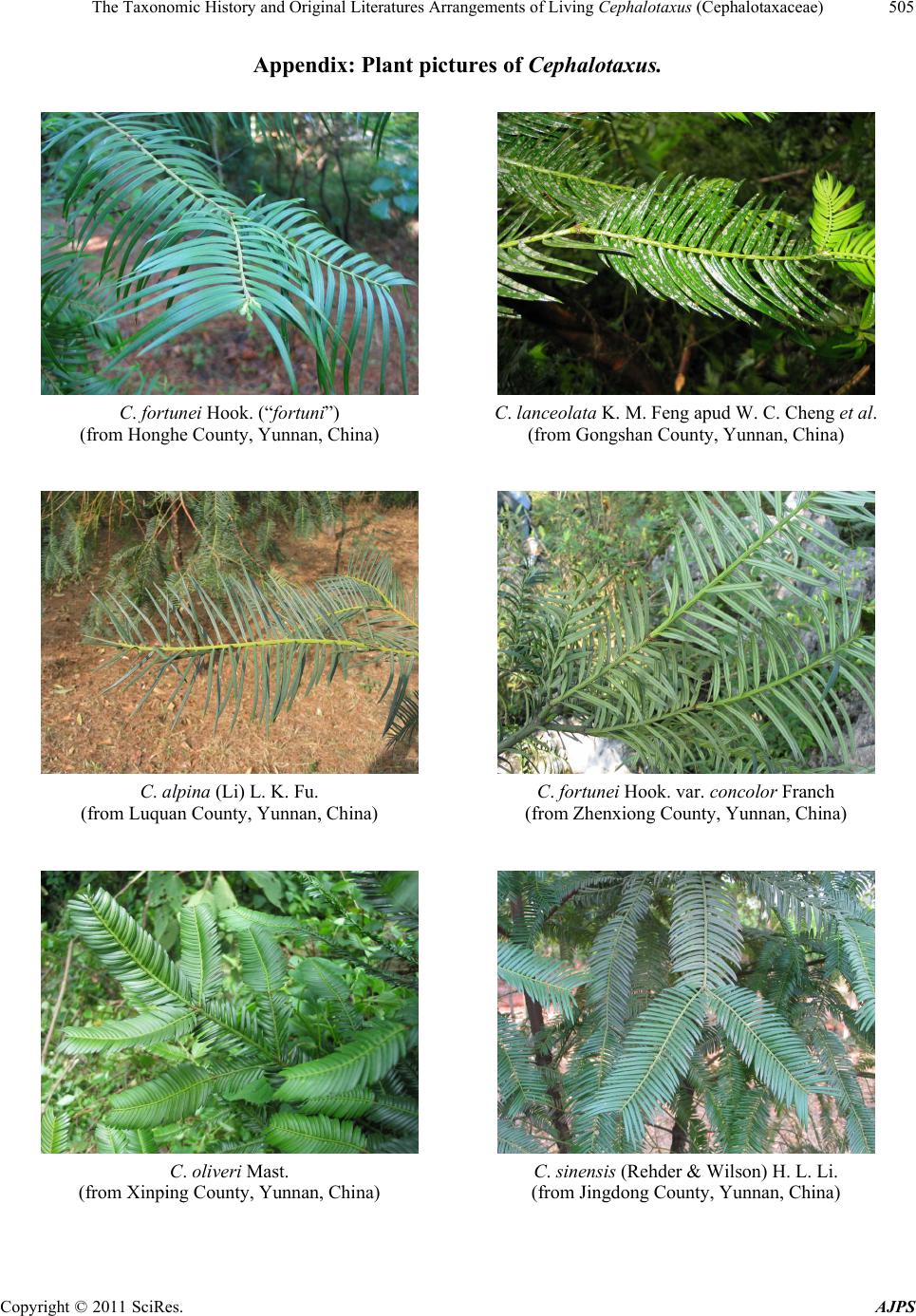 The Taxonomic History and Original Literatures Arrangements of Living Cephalotaxus (Cephalotaxaceae)505 Appendix: Plant pictures of Cephalotaxus. C. fortunei Hook. (“fortuni”) (from Honghe County, Yunnan, China) C. lanceolata K. M. Feng apud W. C. Cheng et al. (from Gongshan County, Yunnan, China) C. alpina (Li) L. K. Fu. (from Luquan County, Yunnan, China) C. fortunei Hook. var. concolor Franch (from Zhenxiong County, Yunnan, China) C. oliveri Mast. (from Xinping County, Yunnan, China) C. sinensis (Rehder & Wilson) H. L. Li. (from Jingdong County, Yunnan, China) Copyright © 2011 SciRes. AJPS 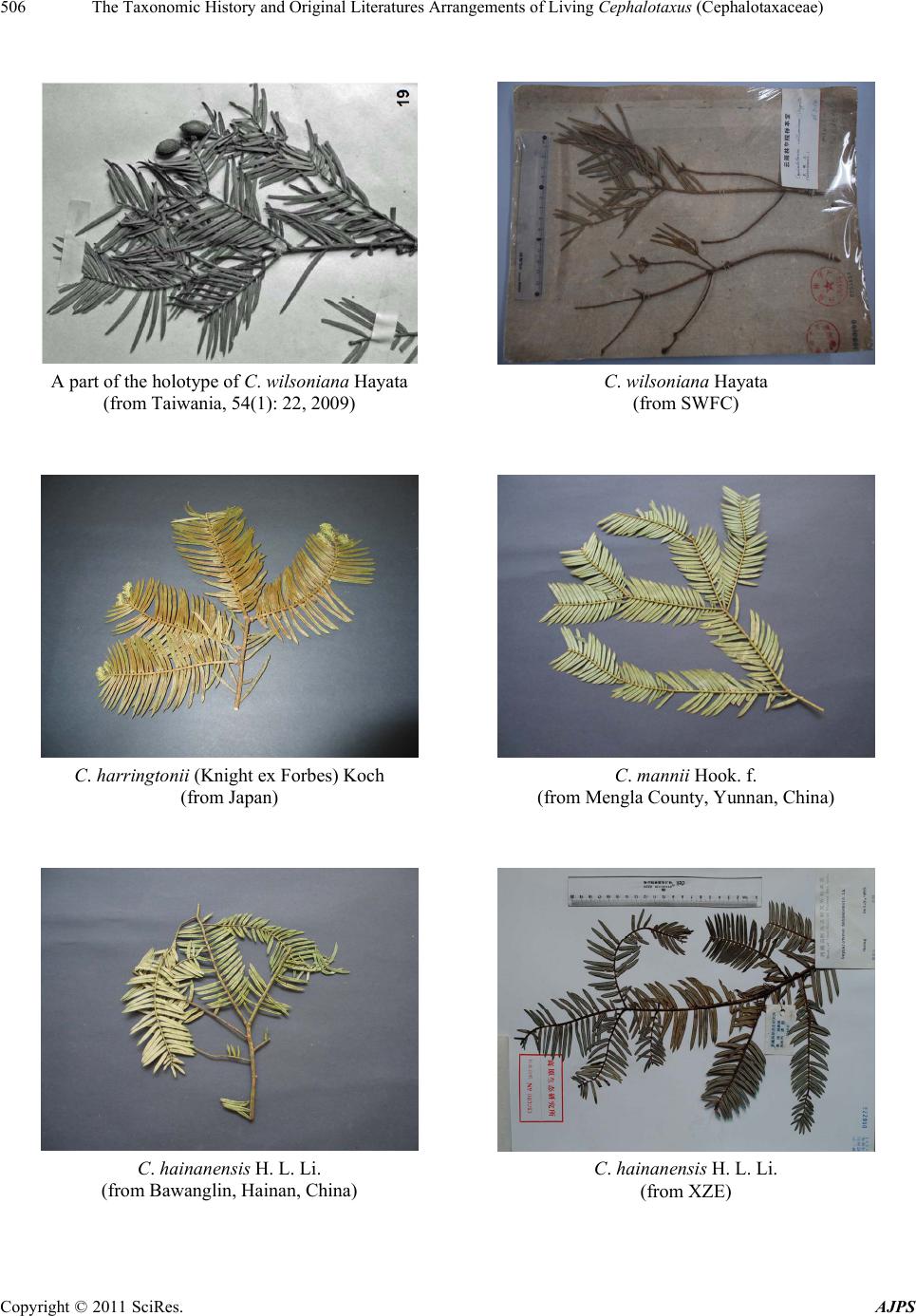 The Taxonomic History and Original Literatures Arrangements of Living Cephalotaxus (Cephalotaxaceae) Copyright © 2011 SciRes. AJPS 506 A part of the holotype of C. wilsoniana Hayata (from Taiwania, 54(1): 22, 2009) C. wilsoniana Hayata (from SWFC) C. harringtonii (Knight ex Forbes) Koch (from Japan) C. mannii Hook. f. (from Mengla County, Yunnan, China) C. hainanensis H. L. Li. (from Bawanglin, Hainan, China) C. hainanensis H. L. Li. (from XZE)
|